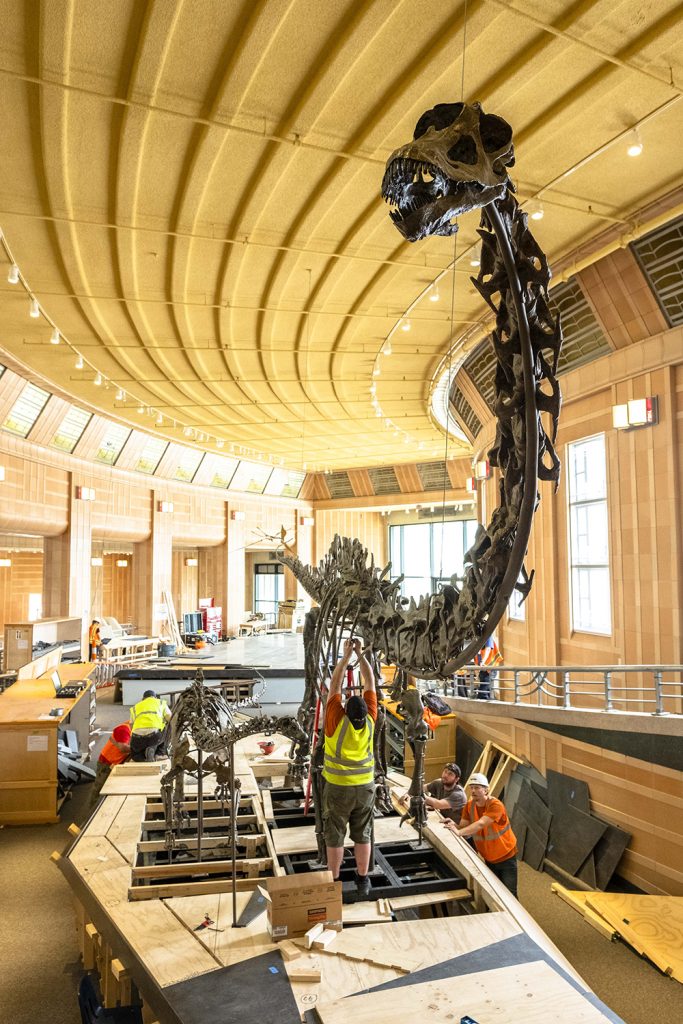It’s May, and paleontologist Glenn Storrs is getting his first look at the dinosaur skeleton of his career on full display in an Over-the-Rhine brewery. The 50-foot-long skeleton of the Galeamopus, which stomped through the northwestern United States about 150 million years ago, stretches across the taproom of Rhinegeist Brewery as part of the Cincinnati Museum Center’s “Curate My Community” initiative. Storrs, curator for vertebrate paleontology at Cincinnati’s Museum of Natural History & Science, delights in watching people ogle his discovery in a setting better known for showcasing edgy ales than prehistoric dinosaur bones. “I always have a big smile on my face when I’m there,” he says during the final days of the temporary exhibit in August. “People are just loving it.”

Photograph by Lance Adkins
Storrs had been anticipating this reaction to his prize find since the day in 2000 that a Montana rancher led him to a few fossilized bones eroding on a hillside in the Bighorn Basin. They didn’t look like much at first, but he saw promise. As he and his crew began the delicate extraction process paleontologists use to explore remnants of the prehistoric world, excitement grew. He remembers thinking There is quite a bit of dinosaur here. This is going to be spectacular. The vision launched Storrs’s 19-year quest to transfer the Galeamopus from the Montana desert to a permanent gallery in the Museum of Natural History & Science in Union Terminal. And now that end goal is near.
CLICK THROUGH OUR GALLERY TO SEE MORE PHOTOS OF THIS EXHIBIT AND DINOSAUR HALL:
Cincinnati Museum Center wraps up its two-and-a-half-year, $224-million restoration of Union Terminal this month. The first permanent galleries reopen to the public November 17, including the Public Landing in the Cincinnati History Museum and Holiday Junction featuring the Duke Energy Holiday Trains. And, of most significance for fossil fans like Storrs, the Museum of Natural History & Science unveils its long-awaited Dinosaur Hall, featuring a rich collection of fossils from giant marquee dinosaurs like Galeamopus to the minuscule plants, clams, and lizard-like animals that were also important to the era.
“It’s essentially the culmination of my career,” says Storrs, who has been collecting and researching dinosaur fossils for the museum for more than 24 years. Over those years, he’s encountered many impressive skeletons. The Galeamopus stands out because it was so well preserved, he says. Over time, dinosaurs’ bones typically break up, erode, and wash away, but the Galeamopus avoided that scattered fate. “We know there’s one tail bone that had been washed away,” Storrs says. “It had to be reproduced. All of the rest was under the ground, and most had been preserved by being buried on a small sandbar in a river or stream system 145 million years ago.” In the end, Storrs and his crew unearthed more than 85 percent of the dinosaur’s bones—an exceptional level of completeness.
In Storrs’s line of work, the excavation process typically draws the most attention. “It seems glamorous going off into the wilderness and excavating something and bringing it back to civilization,” he says. “It’s not as glamorous when you’re actually doing it.” Storrs and a crew of about a half-dozen researchers spent six summers excavating in Montana, loading their finds into pick-up trucks, vans, and car trunks for the three-day trip east. The final piece—a 1.5-ton section that spanned the dinosaur’s hips to shoulders—required a donated trailer and forklift.
After the transport to Cincinnati, Storrs and his colleagues spent years in the lab restoring, identifying, and cataloguing each bone with painstaking precision. Meanwhile, he sold the importance of the skeleton to anyone who could help in his quest to find it a home. He was convincing. In the spring of 2016, museum officials began planning Dinosaur Hall. That’s when Sarah Lima, senior director of project management for exhibits, got involved. She considered both the physical specimens and the scientific analysis provided by Storrs and his colleagues as her team developed the Dinosaur Hall narrative. Visitors will see giants of the past in ways they’ve never imagined as the new exhibit provides vantage points from every level. “A lot of galleries, the only way you can see a dinosaur is to look up,” Lima says. “We want people to be face-to-face with Galeamopus.” Lima says the hall experience will go far beyond displaying the skeletons to provide evidence for how dinosaurs moved, ate, reared their young, and socialized. She hopes the exhibit will remind people that dinosaurs were real, living animals. “They’re not a myth in spite of how crazy big they are.”
For Storrs, the Dinosaur Hall opening will mark a major transition. “My entire life I’ve been interested in studying dinosaurs and collecting dinosaurs,” he says, and this new gallery brings the major skeletons of his lifelong passion together in one spot. He smiles at the thought. “That will be fantastic.”

























Facebook Comments